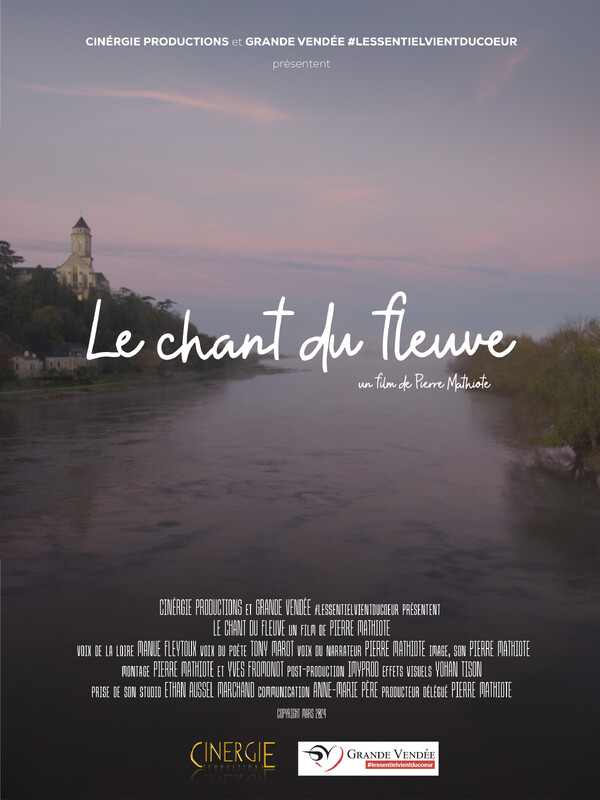
Long métrage 01:23:23 - expérimental - France
Réalisé par / Directed by
Pierre MATHIOTE
2025
Synopsis : Four years of work and five months of filming were necessary to complete this vast poetic over the 1012 kilometers of the Loire. The River’s song tells for the first time a love story between the Woman, the Loire, and the Man, the poet. The Woman and the Man will exchange as a couple can do, from their birth, the source, until their death, the estuary, with their conflicts which are the floods. The film is constructed from some 650 texts by 230 authors, written since the dawn of time on the Loire by poets, travelers and novelists, both known and lesser known. Love at first sight, love, beauty of landscapes, empathy, regrets, pollution, drought, global warming, respect for the environment, floods, castles, stories linked to the river, separation, reunions... are all themes that you will find throughout this original love story lasting 83 minutes.
Four years of work and five months of filming were necessary to complete this vast poetic over the 1012 kilometers of the Loire. The River’s song tells for the first time a love story between the Woman, the Loire, and the Man, the poet. The Woman and the Man will exchange as a couple can do, from their birth, the source, until their death, the estuary, with their conflicts which are the floods, and this, from the work of more than two hundred well-known and lesser-known authors. Love at first sight, love, beauty, empathy, regrets, pollution, respect for the environment, floods, castles, stories linked to the river, separation, reunions... are all themes that you will find in this original 83-minute love story. The River’s song project dates back around twenty years. At the time, no broadcaster or institution wanted it because the project was considered too art-house film. After many achievements for France Télévisions over the past twenty years, I did not want to leave this earth without having achieved my dream. I would have felt like I was betraying myself. When I took up this project in 2020, I had the feeling of making a dissident act. To make this film, my path was that of exodus over more than a thousand kilometers, from the source to the estuary. The River’s song ticks all the boxes of what we call “a creative documentary”. The definition of what a creative documentary is or should be (or author documentary, documentary creation, etc.) is not intended to be approved here, but it allows us to understand more clearly, in contrast, which is not a creative documentary. The creative documentary cannot be excluded from the great history of audiovisual on the pretext that it is different, too creative. He who opposes the immediate resolution of ideas in speech! However, each point of view is a personal bet. It is therefore within the framework of this tension on the word “creation” that I situate my approach to a transversal configuration of the sensible, or if you prefer, of its unity, and of what, standing out, constitutes its immanent principle. : its musicality. In his Writings on Aesthetics, Eugène Delacroix maintains: “There is a kind of emotion which is very particular to painting [...]. There is an impression that results from such an arrangement of colors, lights, shadows, etc. This is what we would call the music of the painting. Before you even know what the painting represents, [...] often you are caught by this magical agreement. » Baudelaire expresses the same intuition of a musical theory of color: “Harmony is at the basis of the theory of color. Melody is unity in color [...]. » This is exactly what I tried to do with The River’s song. An author is one who creates meaning, not by what he says but by the way he says it. I put my whole soul and my whole body into this film. All my heart. No longer connected to the factual but to the millennial heritage of man, local and global. My action takes place over time. The Song of the River is not there only for the pleasure of the eyes and ears, but also, and perhaps above all, to benefit the mind, where consciousness intervenes. To strengthen the brain. And I tell myself that what is valid for the director must also be valid for the young spectator. We must therefore take a leap to escape the fragment, the formatting. Culture involves a journey into the totality of funds and forms. However, many forms are sacrificed on the altar of Audimat. Removing it opens up an infinity of creations, even inventions. This is good television which has the concept of “the invention of possible inventions”. This is a good image in the sense of the image seen. This is a credit to the human race. We can criticize the formatted documentary for what Sartre criticized the bourgeois theater. Most are formal repetitions, exercises, copies of copies. The creative documentary is a physical, carnal object, which requires us to make it speak its own language intended for the senses, as poetry can. It consists of everything which occupies a plane, everything which can be expressed and manifested in a plane and which is addressed primarily to the mind. One resonates while the other reasons. If I go to the theater or the cinema, it is often to be put off, pushed around, and not to be reassured. “What comes into the world so as not to disturb anything deserves neither consideration nor patience,” wrote the French poet and resistance fighter René Char. The formatting uses the same posture
Ce film est inscrit au marché du film.
Service offert lors de l'inscription.
Ce service est sous l'unique responsabilité des ayants droits, vous pouvez gérer ces paramètres dans votre "Espace Personnel" - Rubrique : "Industrie".